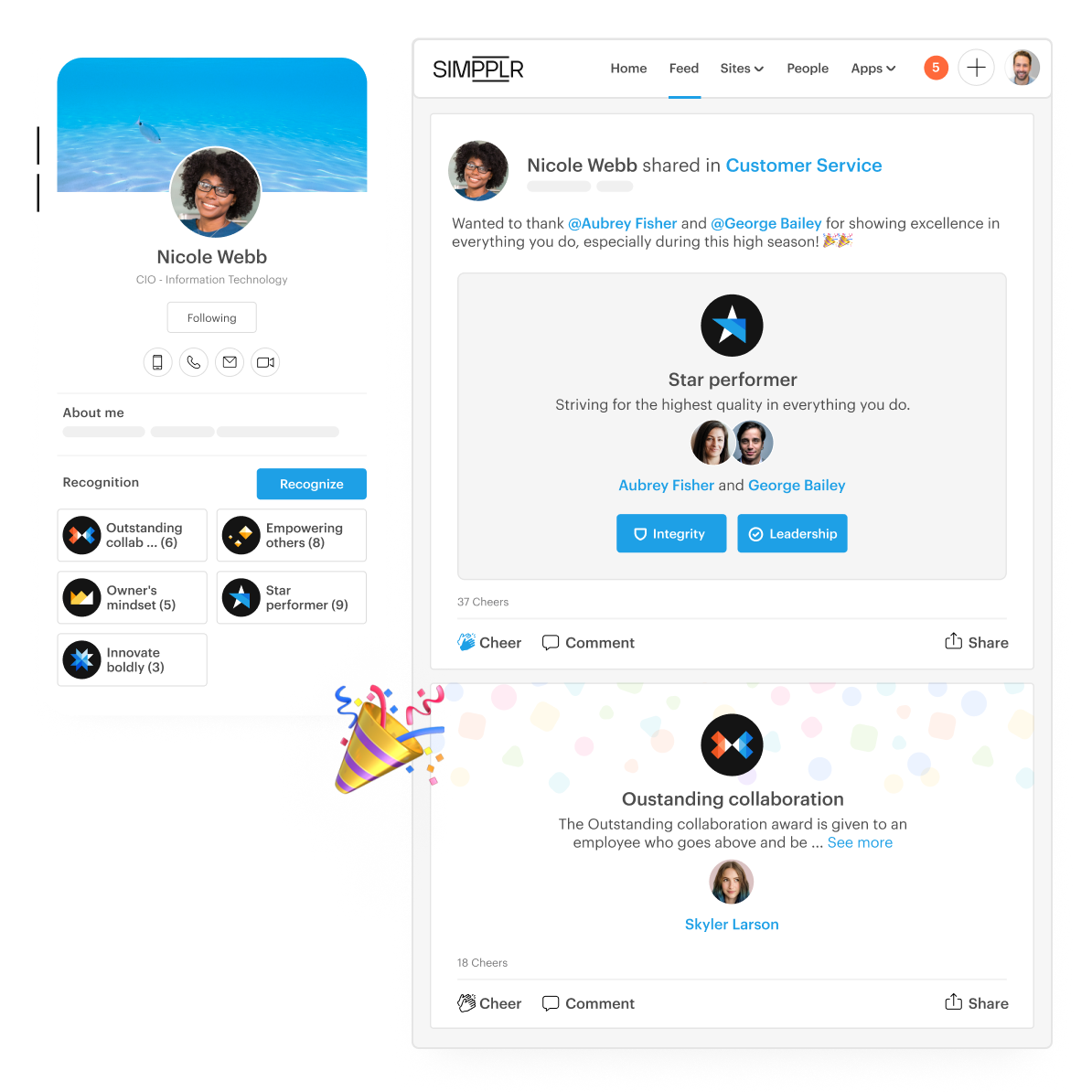If you want to stay competitive to both win and retain top talent, you must build an effective employee engagement strategy. And a critical element of this is an employee recognition program. Why? Employee appreciation is an essential factor in employee engagement and retention.
Consider these statistics:
- Select Software Reviews reported that 66% of employees said they would quit if they didn’t feel appreciated.
- Harvard Business Review found that when managers consistently deliver appreciation, every metric of morale, productivity, performance, customer happiness, and staff retention surges.
- That same Harvard study stated, “Appreciation that is specific is far more powerful than a general ‘good job’ comment.” Describing a specific action and its impact on the team, the organization, or your customers, drives home the value of what the worker has done.
And though it’s an older statistic, in 2018, SHRM found that implementing employee appreciation programs helps develop a positive company culture and increases happiness. Since the pandemic, employee demands for appreciation have increased, making this statistic even more valuable.

Employee recognition and appreciation are crucial factors in creating a positive employee experience. It can lead to increased job satisfaction, motivation, and retention. Learn more about why it’s essential and 12 examples to get started.
What is an employee recognition program?
Simply put, employee recognition programs encourage employees to do a good job and reward them for their efforts and dedication to your company. Implementing employee recognition programs helps maintain high standards of behavior, offers employees motivation and feedback, and publicly recognizes excellent work. Overall, employee recognition is a way to express gratitude for an employee’s successes and efforts.
And employee recognition programs recognize anniversaries, favorable client feedback, or other workplace achievements.

In addition to encouraging a cohesive community within the workspace, there are many benefits to implementing recognition programs, which we’ll discuss below!
Benefits of employee recognition programs
Rewarding exceptional behavior in the workplace can be a tremendous motivator for employees and help to foster a cohesive company culture that values growth and achievement. You can dramatically enhance employee productivity and happiness by investing time and resources in motivating employees and sharing their triumphs with their peers and the organization.
Employee recognition can have a positive impact on an organization in the following ways:
- Enhances employee engagement. Employee appreciation programs have the potential to improve overall employee engagement rates significantly. Employees are more engaged when their efforts are appreciated, leading to higher productivity and innovation in the long run.
- Employee productivity is increased. Employees who feel recognized and appreciated by their employer are more likely to perform better at work. Recognizing employees’ efforts impacts their outlook, happiness, and performance.
- Encourages a cohesive company culture: When executives take the time to recognize individuals who perform well, workers believe that the organization values them. This action strengthens the bonds between managers and their teams. And this bond is especially needed with remote workers who do not come into the office and interact with you daily. The importance of employee recognition for remote workers is critical regarding team building and encouraging a cohesive culture.
- Attract fresh talent: It is critical to attract top talent to your organization to expand within your industry. Many outstanding individuals want to work for an organization that rewards employees for their accomplishments. Implementing employee recognition programs and sharing them with potential new employees will help your recruiting efforts.
- Improves employee retention rates: Employees who do not feel appreciated for their labor and successes are likelier to quit a job than those who do. Leadership recognition can help your organization enhance staff retention and lower turnover rates.
There’s no downside to recognizing what your employees do for your company—though you must understand which rewards work best for your organization.
Employee recognition programs can and should be tailored for your company, as not every worker wants a big celebration; some prefer a thank you card.

Next, we’ll explore how you can show appreciation for the people who make your company work.
12 Examples of employee recognition programs
These employee recognition program ideas below offer a great starting point.
- Employee of the Month/Quarter: This is a traditional recognition program in which you recognize an employee who has exceeded their tasks during the specified time frame. It’s a basic approach, so going above and beyond here is helpful. How can your organization better personalize this achievement for the employee(s)? Rewards and recognitions could translate as a bonus or a personalized gift.
- Peer-to-Peer Recognition: Encourage employees to recognize one another’s efforts by establishing a system to nominate their coworkers for their contributions to the organization. This will help build relationships and create a more cohesive company culture, as employees will feel appreciated by the company and their peers.
- Personalized Thank You Notes: Handwritten notes from managers or team leaders to employees might help them feel appreciated. Not every worker wants their name and pictures up on a board announcing how great they are at their job. Some employees would prefer the intimacy a personalized and handwritten letter or card offers. In an age where it’s much easier and faster to send an email or text, a handwritten note stands out and illustrates that leadership made this thank you a priority and not an afterthought.
- Celebrate Milestones: Celebrate a work anniversary or a notable success for an employee by publicly acknowledging them or giving them a special gift. Everyone wants to be valued and recognized for being an essential part of the team. Celebrating even the simplest events, such as six months with the company, can improve morale and productivity.
- Team Building Events: Plan events for team development, such as a business outing, a game day, or a fun team-building activity—it demonstrates that you value hard work and want to enjoy some fun. It also gives organizations a chance to get better acquainted with their workers and for employees to get to know one another better outside of the workplace. And, of course, this contributes to building a better team and a more cohesive company culture.
- Gift Cards or Vouchers: Giving gift cards or vouchers to employees as a form of reward is an excellent method to express your gratitude. They could be for a restaurant, a cinema, or an online business. The more personalized you can make this gift, the better–it will let employees know that you’re not absent and instead care about them on a more personal level.
- Flexibility and Perks: Sure, a photo on a board is great, but offering employees flexibility and advantages like as flexible scheduling, work-from-home possibilities, and longer vacation days demonstrate that you value their contributions to the organization, you trust them as employees, and you want to give back.

- Highlight your employee in marketing materials: Highlighting employees in the company’s marketing materials is a terrific method to acknowledge hard work and rising talent. You can collaborate with the marketing department to establish which platforms to highlight employee accomplishments. Your employee may participate in the corporate podcast to discuss their professional path, or the worker may compose an article for the company’s monthly newsletter, which you will publish. There are many ways to tailor this to your own company’s needs.
- Employee wellness incentives: Inadequate attention to employee well-being is a top reason for high employee turnover rates. And this makes employee wellness programs an excellent option for employee recognition programs. You can choose rewards that boost your employees’ emotional and physical wellness. Management can use employees’ interests to personalize wellness benefits. Ideas include gym or hiking subscriptions, spa certificates, nutritional consultations, physical fitness items such as running shoes or yoga mats, or access to mental health sessions or seminars.
- Personalized swag packages: We aren’t talking coffee mugs with your employee’s name on them—Jenny might like that, but perhaps she’d prefer a package more tailored to her interests, including cats and red wine tastings. Explore your employees’ hobbies/interests and put the swag in fun and fashionable bags or packaging. Swag packages will help your company brand and promote staff gratitude and recognition.
- Annual employee appreciation celebrations: Get your whole company involved and celebrate what every individual does for the organization. Make it a yearly tradition where you throw your employees a party celebrating their expertise and efforts towards making your company great. You could hold a ceremony that recognizes individual employees for achievements such as customer service or going the extra mile when it wasn’t required or asked.
A company that embraces a culture that rewards employees for quality work, encourages better employee engagement and fosters a better overall employee experience.
And we have a few tips organizations should consider . . .
Tips for implementing an employee recognition program
- Make it a routine. Instead of a one-time event, make employee recognition a regular part of your management style. The more you acknowledge your employees, the more likely they feel valued.
- Give out random recognition. Consider delivering praises and gratitude at random or unexpected times unrelated to any event or organized acknowledgment. Because it is not tied to a quarterly award or a regularly scheduled workplace function, it demonstrates that it’s genuine and authentic.
- Make it specific and personal. Instead of merely stating “good job,” describe what the individual accomplished to deserve appreciation. Explain how they influenced their team and the company. Provide measurable results to give it more significant meaning.
- Provide equal opportunity. Because employee recognition is frequently awarded publicly to enhance morale, it is critical to implement a recognition approach that is accessible to all employees. Make it clear and detailed what is required to receive them. Your team should have an equal opportunity to succeed.
If you’d like to know more about personalizing your employees’ experiences—from their daily work to employee recognition programs—reach out for a demo!

















